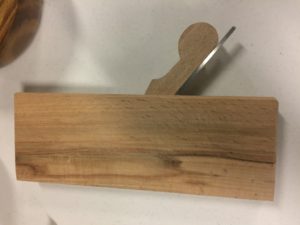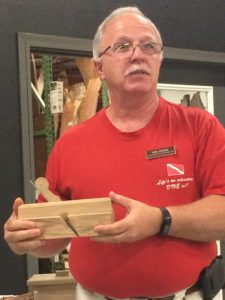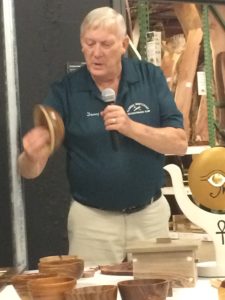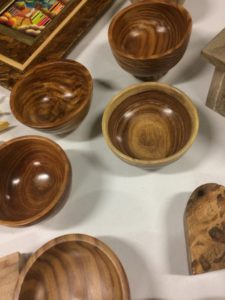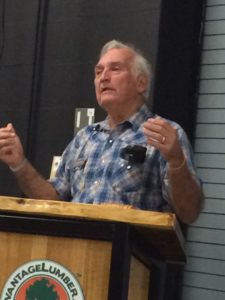 Club president Joe Mannke called the meeting to order at 7:00 PM. Thirty-Nine members and two guest signed in.
Club president Joe Mannke called the meeting to order at 7:00 PM. Thirty-Nine members and two guest signed in.
Business Meeting Report:
- Brazilian Charity Joe Mannke announced that the Board has set aside $750.00 this year to assist in purchasing food baskets for Advantage Lumber Brazilian mill workers. In addition, any members who wish to make an individual donation can do so by making a check out to Florida Westcoast Woodworkers Club and indicating on the check that is for the Brazilian food baskets.
- Bank Surplus Joe reported that our bank account is still showing a surplus above projected operating expenses and that the Board is considering speakers requiring a higher honorarium or the establishment of a scholarship fund.
- 2 x 4 Contest There has been discussion about the 2 x 4 contest, and any non wood materials used. Some members think the entries should be presented by the maker prior to voting so that any special construction features could be explained. Some members thought some of this year’s entries had too much non-wood components. The board has debated the need for more rules or less rules. Maybe a judge is needed to determine if an entry conforms or not. Is intarsia to be allowed if it used a plywood backing, as most do? Should someone make a working guitar from a 2 x 4 is the entry to be disallowed if it has steel strings or metal frets? Further discussion is warranted if there is interest from the membership. Is there anyone willing to gather up differing points of view on the contest rules or procedures? If nothing else, anyone can certainly vote their conscience at the annual picnic.
- Picnic Moved The annual picnic is being moved to the Farmer’s Bureau on East Street just off of Fruitville Road and east of the interstate. This facility provides plenty of tables and chairs, and the word on the street is that we need to bring our own toilet paper. Here is your reminder for the last Sunday in March of 2019, so start your wooden 2 x 4 project early. We have the facility all day long.
- Outreach Opportunity The Sarasota Farmer’s Market has offered to allow us to set up an information booth, and to display the various items our members make during the year. Are there any ideas of how to solve the logistical problems of setting up a display and gathering and storing wood items every week? How about if an items gets lost or damaged?
- New Logo? The club logo contest is still open to any member wishing to draw up a new logo. When voting begins, one option will be to keep our existing logo.
- Mentors Wanted There are spots open for willing participants at the Easter Seals campus.
- Hungry Bowls The bowls for hunger project is continuing and some bowl blanks are still available, see Denny Wetter. The bowls will be given to the Manatee County Food Bank late this fall.
- Speakers Circuit Joe has been in contact with other area clubs to find interest in creating an informal speakers bureau in which presenters travel a circuit among various clubs. A club in Lakeland now wants to participate. The availability of speakers would make the president’s job easier.
- Shop Meet This month’s shop meet is scheduled for May 21, 2018 at the shop of Ed Columbo.
Presentation:
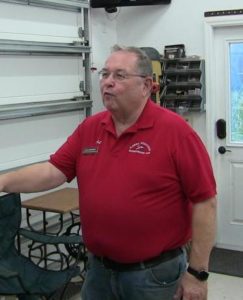 The feature presentation was by Al Brown on Sharpening.
The feature presentation was by Al Brown on Sharpening.
Al began his presentation by stating that he enjoys learning and researching a topic, and that is what he has done in reference to sharpening. He has assembled a page of websites composing a digital library, from which he has gathered his information and he offers us access via sending an email to capt.al.brown@gmail.com.
Here is a link to the index for Al’s library
Al offers the following insights from his research on sharpening. A tool is sharp when it makes a clean cut with controlled depth, direction, and with an efficient focus on tool placement and movement. Sharp means the intersection of two polished planes. The flatter the point, the sharper the tool, and the faster it will dull. Once the tool dulls, one should keep in mind the following sharpening goals:
- Sharpening should be fast
- Sharpening should be easy
- Sharpening should be affordable
- Sharpening should remove the least amount of material.
Tool edges should be durable, that is the tool should perform repeatedly with minimum maintenance. The method changes with the tool and the tool material and hardness.
Al offers guidelines for bevel angles depending on the use. For knives, he suggests 15 to 45 degrees. Chisels are usually 25 or 30 degrees with a small micro bevel on the front cutting edge, with the back flat. Plane blades are often 25 degrees, keeping in mind that the cutting edge is also composed of the included angle of the plane. And contrary to chisels, plane blades have a small micro bevel on the back of the blade opposite the bevel edge, and thus eliminating the need to flatten the entire back of the plane blade. He suggests micro bevels of no less than 2 up to a maximum of 5 degrees.
Al asked if anyone has heard of the scary sharp system, and most of the room said yes. Al’s comment is that sandpaper dulls in an irregular pattern and may not work well on the harder steels. He says this is the most expensive system in the long run, since sandpaper wears out so quickly on steel.
Al says that grinders are ubiquitous in sharpening, with examples of various stones. He cautions that diamond grinder wheels are not for woodworking, and suggests cubic boron nitride (CBN) wheels for wood turning. He suggests using a stabilizing washer if the grinder or wheels do not run true.
Al demonstrated the Robo rest, made by Robohippy of Youtube fame. The robo rest features a repeatable set up step to zero out the grinding angle and is shaped similar to the rest popularized by Cindy Drozda, another wood turner of You tube fame, and who has been hosted here by the local wood turner’s club.
As Al was running out of time, he showed various natural, artificial, and diamond stones with the thought that each has a place in a sharpening arsenal. Just remember, he said, stones need to be flattened!
Show and Tell:
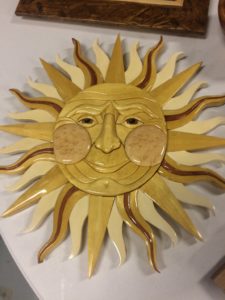
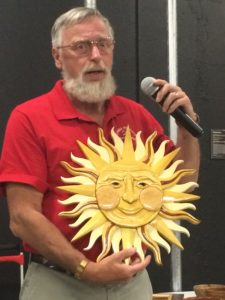 John Peasely presented a Sunburst intarsia piece made of aspen, cherry, ebony, yellow heart, cedar, and maple with a total of 92 pieces, but then again, who is counting?
John Peasely presented a Sunburst intarsia piece made of aspen, cherry, ebony, yellow heart, cedar, and maple with a total of 92 pieces, but then again, who is counting?
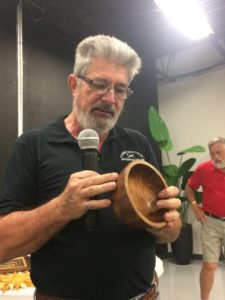
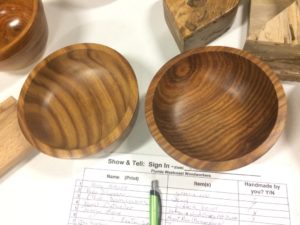 Andrew DiLorenzo showed two rosewood bowls in progress, both with different finishes.
Andrew DiLorenzo showed two rosewood bowls in progress, both with different finishes.
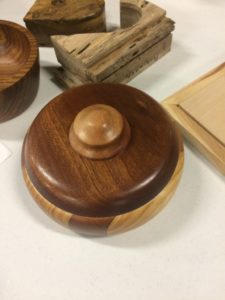
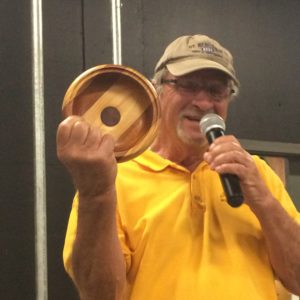 Fred Damianos brought in a bowl that went from a funnel to a candy dish with the addition of two contrasting woods in the bottom.
Fred Damianos brought in a bowl that went from a funnel to a candy dish with the addition of two contrasting woods in the bottom.
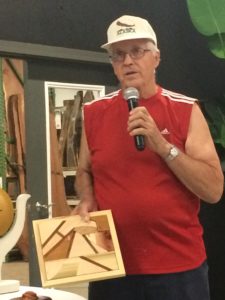
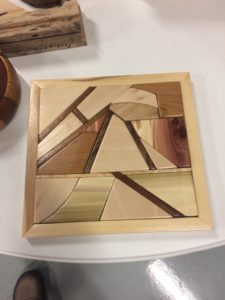 Raoul Detweiler showed his intarsia version of a crazy patch quilt with pieces that fit together like a puzzle.
Raoul Detweiler showed his intarsia version of a crazy patch quilt with pieces that fit together like a puzzle.
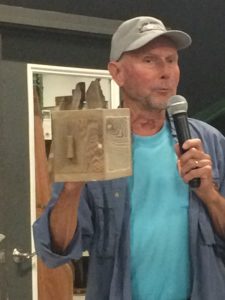
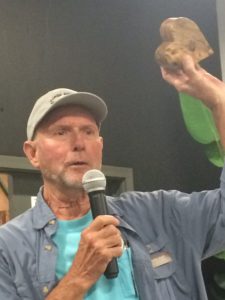
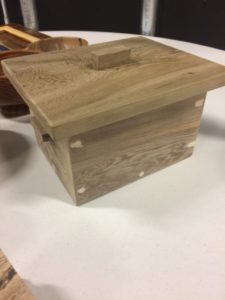 Terry Bair said a piece of persimmon wormed its way into his heart, with the report that something moved as he was making it. He also had a treasure box proud-fully assembled by one of the people he mentors. He said the pieces were mostly pre-cut save for some smaller parts.
Terry Bair said a piece of persimmon wormed its way into his heart, with the report that something moved as he was making it. He also had a treasure box proud-fully assembled by one of the people he mentors. He said the pieces were mostly pre-cut save for some smaller parts.
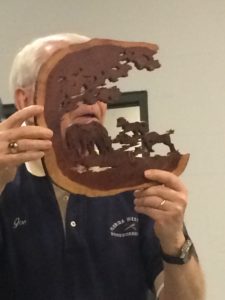
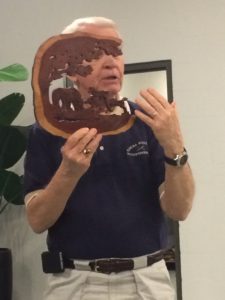 Joe Mathis showed a scroll saw piece with wood that is still developing cracks. No offers of a solution were made.
Joe Mathis showed a scroll saw piece with wood that is still developing cracks. No offers of a solution were made.
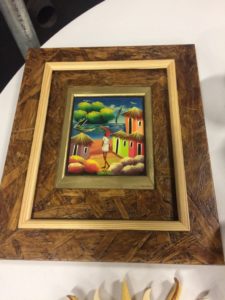
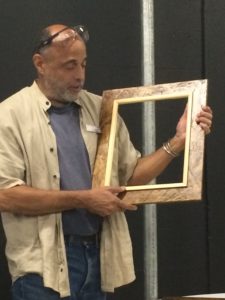 Mike Dummet had a pair of picture frames made from recycled osb packing material. One had solid wood framing the interior of the frame next to the intended art work.
Mike Dummet had a pair of picture frames made from recycled osb packing material. One had solid wood framing the interior of the frame next to the intended art work.
Kim Jones made a hand plane from a block of wood and a piece of tool steel. The plane is used to make period furniture calling for the use of a # 12 hollowing plane. Of course, the wood was all hand planed. He cut, shaped, hardened, and then tempered the tool steel himself.
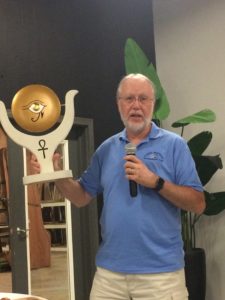
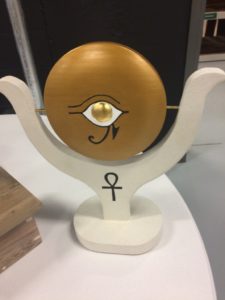 Dennis Daudelin showed a gong used to summon the god RA in an ancient Egyptian theme. The painted piece had a travertine finish to mimic that found in Egypt.
Dennis Daudelin showed a gong used to summon the god RA in an ancient Egyptian theme. The painted piece had a travertine finish to mimic that found in Egypt.
Denny Wetter brought in some bowls destined for the hungry bowls charity with examples of wax and other finishes.
Raffel:
The raffle winners were Neil McCullough, Barry Taylor, and Fred Damianos.
Written by:
Andrew DiLorenzo

